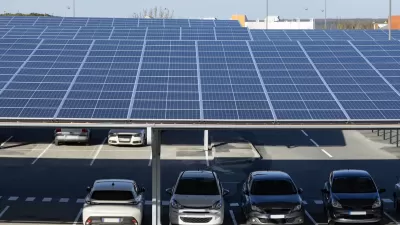In the last week to sign bills, Gov. Jerry Brown signed AB 327 that allows utilities to charge all ratepayers for costs incurred to the grid by rooftop solar and allows those who have it to 'run the meter backwards', known as net metering.
Chris Clarke explains the controversy behind AB 327. It allows utilities to charge a fixed fee of up to $10 "to recoup what they claim are costs unfairly incurred in providing rooftop solar customers backup power during times when their solar panels aren't producing power". The charge was opposed by those who saw it as regressive and unrelated to the power consumption of the household or presence of rooftop solar. However, as the governor noted in his signing message (PDF), it allows the Calif. Public Utility Commission to design new rates to give discounts to low-income households.
Solar owners will benefit with the removal of the state's net metering cap, currently "5 percent of each utility's average peak power demand", that will ensure new customers for the state's solar installation industry. Consequently the Solar Energy Industry Association "applaud(ed) Gov. Brown for his unwavering commitment to clean energy"
Under current arrangements, rooftop solar owners may not receive the full financial benefit of their system. AB 327 changes that billing system to the benefit of the homeowner.
Under net metering arrangements (also called Net Energy Metering, or NEM), rooftop solar owners can run their electric meters backward when their solar panels are feeding excess energy into the grid.
Brown also signed AB 217 that "extends two programs designed to help lower-income Californians go solar", one being for multi-family housing. Funding comes from "channel(ing) 10 percent of the California Solar Initiative's (CSI) funding toward helping California's poorest residents go solar.:
Under the programs, very low income households can get solarized with a subsidy paying all the costs. A sliding scale reduces the subsidy for people with more resources.
The CSI would have exhausted its funding in 2016. It will now be extended for another five years.
FULL STORY: California Governor Signs Controversial Solar Bill, Among Others

Maui's Vacation Rental Debate Turns Ugly
Verbal attacks, misinformation campaigns and fistfights plague a high-stakes debate to convert thousands of vacation rentals into long-term housing.

Planetizen Federal Action Tracker
A weekly monitor of how Trump’s orders and actions are impacting planners and planning in America.

In Urban Planning, AI Prompting Could be the New Design Thinking
Creativity has long been key to great urban design. What if we see AI as our new creative partner?

Pedestrian Deaths Drop, Remain Twice as High as in 2009
Fatalities declined by 4 percent in 2024, but the U.S. is still nowhere close to ‘Vision Zero.’

King County Supportive Housing Program Offers Hope for Unhoused Residents
The county is taking a ‘Housing First’ approach that prioritizes getting people into housing, then offering wraparound supportive services.

Researchers Use AI to Get Clearer Picture of US Housing
Analysts are using artificial intelligence to supercharge their research by allowing them to comb through data faster. Though these AI tools can be error prone, they save time and housing researchers are optimistic about the future.
Urban Design for Planners 1: Software Tools
This six-course series explores essential urban design concepts using open source software and equips planners with the tools they need to participate fully in the urban design process.
Planning for Universal Design
Learn the tools for implementing Universal Design in planning regulations.
planning NEXT
Appalachian Highlands Housing Partners
Mpact (founded as Rail~Volution)
City of Camden Redevelopment Agency
City of Astoria
City of Portland
City of Laramie





























